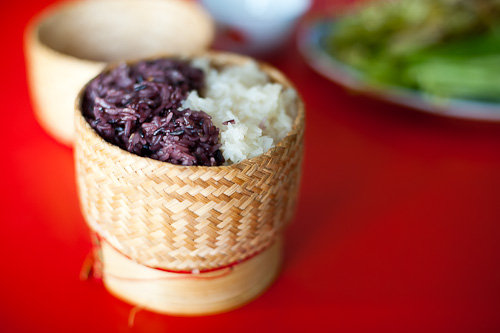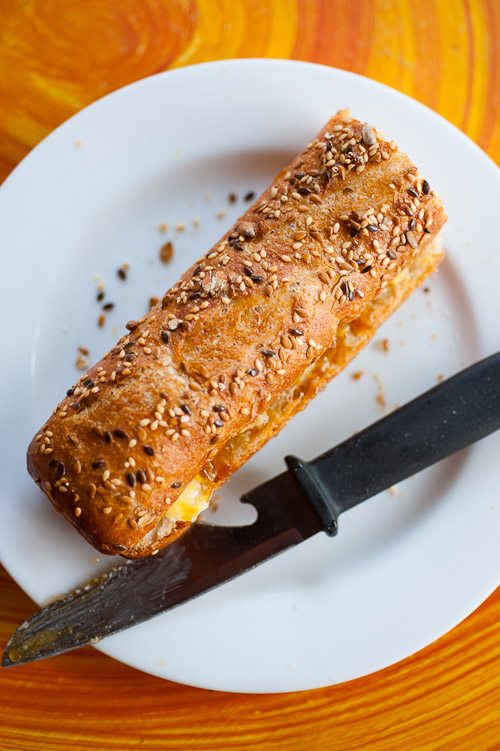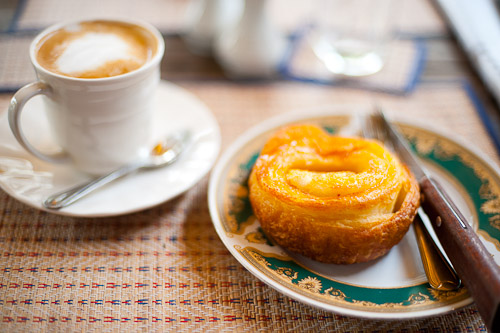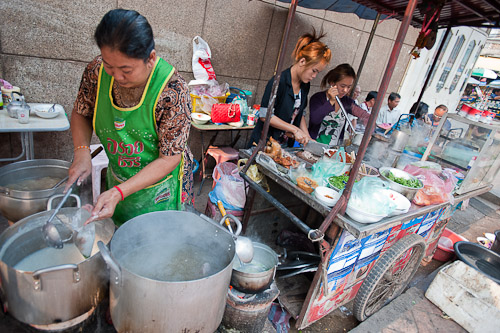 After more than a month in Vientiane, I have to admit that it's still the case that I've still only been able to find a scant handful of places that do good Lao food. Luckily I live literally around the corner from one that I, not to mention many locals, consider the best place in town.
After more than a month in Vientiane, I have to admit that it's still the case that I've still only been able to find a scant handful of places that do good Lao food. Luckily I live literally around the corner from one that I, not to mention many locals, consider the best place in town.
Nang Kham Bang ('Ms Khambang'), or as the sign says, Khambang Lao Food Restaurant, is a third-generation family run place serving a relatively short but solid menu of Lao dishes. I’ve eaten here at least eight times now, both by myself and with others, and can say with confidence that the kitchen is consistent and service is also good, the latter a true rarity in Laos.
Just about everything here suggests quality, even down to the good-quality and perfectly steamed sticky rice:

The house dish is fish (pictured at the top of this post), in the form of a half or whole paa neua on (a type of freshwater fish) lightly seasoned and grilled. Mekong River fish is also featured in kaeng som paa, a sour fish-based tom yam-like soup with lots of dill, bai menglak (a basil-like herb), shallots and galangal:

They do an excellent sai ua:

a Lao-style sausage, often associated with Luang Prabang, that’s less herbal than its similarly-named Thai counterpart. Other good meat dishes are a sublime grilled beef tongue:

very good laap:

including an excellent koy plaa (like laap, but made with larger chunks of freshwater fish), and jee sin lot:

strips of beef that have been grilled until charred then scraped of all the burnt bits and pounded until tender.
Other dishes worth ordering are or laam, a thick stew-like stew of beef or pork with lots of herbs and vegetables; a very good jaew mak len, a dip of grilled tomatoes; and I reckon their tam maak hung (som tam -- papaya salad), served here with tiny crispy tomatoes and even tinier freshwater shrimp, is the best version of the dish I've encountered yet in Laos.
Khambang Lao Food Restaurant 97/2 Th Khounboulom +85 217 198 10am-10pm
View Thai Eats in a larger map












 Watching a pétanque game
Watching a pétanque game Moving back in time slightly, while home a couple weeks ago I also had my first chance to cook in a month: I made cozido à Portuguesa from
Moving back in time slightly, while home a couple weeks ago I also had my first chance to cook in a month: I made cozido à Portuguesa from  Actually this photo could have been taken just about anywhere in Laos; it illustrates a typical scenario that unfolds upon pulling into any rural bus station here. Even before the bus comes to a complete stop, women frantically run to the bus waving sticks of grilled chicken, bags of sticky rice or mangoes, grilled eggs, buckets of drinks and tubes of nyaa dom (nasal inhalers). I don't tend to see too many purchases, but the number of vendors suggests it must be at least a somewhat profitable venture.
Actually this photo could have been taken just about anywhere in Laos; it illustrates a typical scenario that unfolds upon pulling into any rural bus station here. Even before the bus comes to a complete stop, women frantically run to the bus waving sticks of grilled chicken, bags of sticky rice or mangoes, grilled eggs, buckets of drinks and tubes of nyaa dom (nasal inhalers). I don't tend to see too many purchases, but the number of vendors suggests it must be at least a somewhat profitable venture. Am back in Vientiane after an all-too-brief visit to Bangkok followed by a week in the central Lao province of Savannakhet. And what a week it's been... My job at the moment is essentially to walk around towns in Laos and gather information, a task that's been made increasingly difficult by the arrival of summer here in Southeast Asia. Although I've lived in the region for over a decade now, I've only spent a couple summers here, typically having spent this time of year at home in Oregon or Sweden, or somewhere else cool. As a result, the intense heat feels relatively new to me, and is almost unbearable, particularly for one who's walking as much as 10km or more a day. I honestly don't think I've ever sweated so much in my life, but rehydrating in Savannkhet was a literal pleasure, thanks to
Am back in Vientiane after an all-too-brief visit to Bangkok followed by a week in the central Lao province of Savannakhet. And what a week it's been... My job at the moment is essentially to walk around towns in Laos and gather information, a task that's been made increasingly difficult by the arrival of summer here in Southeast Asia. Although I've lived in the region for over a decade now, I've only spent a couple summers here, typically having spent this time of year at home in Oregon or Sweden, or somewhere else cool. As a result, the intense heat feels relatively new to me, and is almost unbearable, particularly for one who's walking as much as 10km or more a day. I honestly don't think I've ever sweated so much in my life, but rehydrating in Savannkhet was a literal pleasure, thanks to 


 Am back home in Bangkok, for a few days anyway, and one of the places I wanted to eat at and blog about was a restaurant I came upon only relatively recently. Tang Jua Lee is a longstanding restaurant in Bangkok's Chinatown, but since undergoing a relatively recent a face-lift, has something of a modern feel:
Am back home in Bangkok, for a few days anyway, and one of the places I wanted to eat at and blog about was a restaurant I came upon only relatively recently. Tang Jua Lee is a longstanding restaurant in Bangkok's Chinatown, but since undergoing a relatively recent a face-lift, has something of a modern feel:






 Seen on a roadside in Vang Vieng, Laos. At first I assumed the bra reference was some sort of not-so-subtle sexy advertising technique, but apparently it's meant literally, and according to
Seen on a roadside in Vang Vieng, Laos. At first I assumed the bra reference was some sort of not-so-subtle sexy advertising technique, but apparently it's meant literally, and according to  Talat laeng, evening markets, are, outside of eating at somebody's home, the best place in Laos to find authentic food. The only downside is that, unless you live there, you'll likely need plates, silverware and a place to eat. But if you can manage this, the below are a couple of the better talat laeng in Vientiane.
Talat laeng, evening markets, are, outside of eating at somebody's home, the best place in Laos to find authentic food. The only downside is that, unless you live there, you'll likely need plates, silverware and a place to eat. But if you can manage this, the below are a couple of the better talat laeng in Vientiane.









 Swensens and the Pizza Company officially opened yesterday in Vientiane. They're the first branches of an international fast-food franchise to open in Laos, although it's worth mentioning that this sort of Western food has been available in Vientiane for a while. At least they didn't pull a China or Russia and put them up near some sacred historical district or monument; the restaurants sit virtually next door to the equally tasteless Lao National Culture Hall.
Swensens and the Pizza Company officially opened yesterday in Vientiane. They're the first branches of an international fast-food franchise to open in Laos, although it's worth mentioning that this sort of Western food has been available in Vientiane for a while. At least they didn't pull a China or Russia and put them up near some sacred historical district or monument; the restaurants sit virtually next door to the equally tasteless Lao National Culture Hall. I've been in Vientiane, Laos for the better part of a month now and during this time, my breakfast has hardly diverged from two places. Most days I'll head for Le Banneton, a French bakery in the centre of town. Usually I'll eat in and order their excellent cafe latte (brewed with Lao beans) and a sweet-ish pastry, such as
I've been in Vientiane, Laos for the better part of a month now and during this time, my breakfast has hardly diverged from two places. Most days I'll head for Le Banneton, a French bakery in the centre of town. Usually I'll eat in and order their excellent cafe latte (brewed with Lao beans) and a sweet-ish pastry, such as 


 Sam Euay Nong ('Three Sisters') is a cheery, tidy family-run place in central Vientiane. They do a handful of simple Lao/Vietnamese dishes, ranging from tam mak hung, Lao-style papaya salad, to khao poon nam jaew, thin rice noodles in broth with pork and bamboo, all of which are full of flavour and well executed, but my favourite dish of theirs is probably naem khao.
Sam Euay Nong ('Three Sisters') is a cheery, tidy family-run place in central Vientiane. They do a handful of simple Lao/Vietnamese dishes, ranging from tam mak hung, Lao-style papaya salad, to khao poon nam jaew, thin rice noodles in broth with pork and bamboo, all of which are full of flavour and well executed, but my favourite dish of theirs is probably naem khao.
 Driving along Rte 13 about 25km north of Vang Vieng, I passed by this roadside market, bordered by a stream and shaded by tall limestone cliffs:
Driving along Rte 13 about 25km north of Vang Vieng, I passed by this roadside market, bordered by a stream and shaded by tall limestone cliffs:





 Fishing on the Nam Song, Vang Vieng, Laos
Fishing on the Nam Song, Vang Vieng, Laos Selling CDs near Pha That Luang, Vientiane, Laos
Selling CDs near Pha That Luang, Vientiane, Laos Phở, Vietnamese-style rice noodle soup, is probably the most popular noodle dish in Laos, but a few things set it apart from the dish of its origins. Firstly, the noodles used in Lao phở generally aren't very high quality, and tend to be somewhat coarse and pasty. And Lao phở broth often lacks the deep meatiness of its Vietnamese counterpart (I suspect they attempt to remedy this by adding heaps of MSG). But I reckon the thing that makes Lao phở most different than the Vietnamese style is the number of condiments:
Phở, Vietnamese-style rice noodle soup, is probably the most popular noodle dish in Laos, but a few things set it apart from the dish of its origins. Firstly, the noodles used in Lao phở generally aren't very high quality, and tend to be somewhat coarse and pasty. And Lao phở broth often lacks the deep meatiness of its Vietnamese counterpart (I suspect they attempt to remedy this by adding heaps of MSG). But I reckon the thing that makes Lao phở most different than the Vietnamese style is the number of condiments:
 Boy near Pha That Luang, Vientiane, Laos
Boy near Pha That Luang, Vientiane, Laos  Praying at Wat Si Muang, Vientiane, Laos
Praying at Wat Si Muang, Vientiane, Laos Not from me of course, but from Phia Sing, a former royal cook in the palace of Luang Prabang. The 115 recipes, originally written on notebook paper by Phia Sing, and later compiled and edited by former British diplomat,
Not from me of course, but from Phia Sing, a former royal cook in the palace of Luang Prabang. The 115 recipes, originally written on notebook paper by Phia Sing, and later compiled and edited by former British diplomat,  After two weeks in Vientiane I have to admit that I’ve found relatively little in the way of Lao food worth sharing. I’ve encountered one exceptionally good Lao restaurant, a decent phở' stall and a pretty solid night market, all of which I’ll blog about soon, but for the most part I get the impression that the vast majority of people here appear eat dinner at home, and when eating out, require little more a bit of grilled meat and Beerlao. This is unfortunate for visitors, as Lao food really can be good, but I imagine that much of what people manage to eat here is either gentrified for foreigners, or as is more often the case, just kinda crappy.
After two weeks in Vientiane I have to admit that I’ve found relatively little in the way of Lao food worth sharing. I’ve encountered one exceptionally good Lao restaurant, a decent phở' stall and a pretty solid night market, all of which I’ll blog about soon, but for the most part I get the impression that the vast majority of people here appear eat dinner at home, and when eating out, require little more a bit of grilled meat and Beerlao. This is unfortunate for visitors, as Lao food really can be good, but I imagine that much of what people manage to eat here is either gentrified for foreigners, or as is more often the case, just kinda crappy.
 Recently Global Post Thailand Correspondent
Recently Global Post Thailand Correspondent 
 Inside the Lao Brewery Company, Vientiane, Laos
Inside the Lao Brewery Company, Vientiane, Laos At the Lao Brewery Company outside Vientiane, Laos
At the Lao Brewery Company outside Vientiane, Laos Inside the Lao Brewery Company, Vientiane, Laos
Inside the Lao Brewery Company, Vientiane, Laos  Inside the Lao Brewery Company, Vientiane, Laos
Inside the Lao Brewery Company, Vientiane, Laos Glasses of Beerlao at a restaurant in Vientiane, Laos
Glasses of Beerlao at a restaurant in Vientiane, Laos At the Lao Brewery Company, located outside Vientiane, Laos
At the Lao Brewery Company, located outside Vientiane, Laos